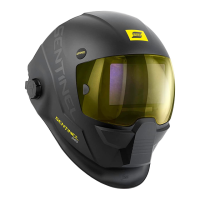
Do you have a question about the ESAB Sentinel A60 and is the answer not in the manual?
| Optical Class | 1/1/1/1 |
|---|---|
| Shade Range | 5-13 |
| Sensors | 4 |
| Delay Control | 0.1 - 1.0 s |
| Battery Type | CR2450 |
| Power Supply | Solar cell and replaceable battery |
| Weight | 640 g |
| ADF Technology | Yes |
| Switching Speed | 1/25, 000 s |
| Standards | EN379, EN175 |
| Battery Life | Up to 3000 hours |
| Viewing Area | 100 x 60mm (3.93 x 2.36 in.) |
Explains the hazard warning symbols used in the manual for immediate attention and alerts.
Lists essential safety measures and warnings before operating the auto-darkening welding helmet.
Details the hazards of arc radiation, UV exposure, and hot metal burns during welding.
Highlights the risk of hearing damage from excessive noise and the need for ear protection.
Discusses the dangers of welding fumes and gases, including asphyxiation and toxic reactions.
Outlines measures to prevent fires and explosions caused by welding sparks, hot metal, and combustible materials.
Recommends publications for further safety practices related to welding and cutting equipment.
Provides specific warnings mandated by California law regarding chemicals in welding fumes and lead exposure.
Covers the process of installing batteries and understanding the battery level indicator.
Explains the LED display functions and basic button controls for the auto-darkening filter.
Details how to switch the helmet between welding mode and grind mode for different applications.
Describes how to adjust the shade number for optimal protection based on welding current and process.
Explains how to adjust the sensitivity of the auto-darkening filter to ambient light conditions.
Details how to adjust the delay time for the lens to return to a light state after welding.
Explains how to save and recall up to nine custom parameter settings for shade, sensitivity, and delay.
Describes how to lock the shade setting to prevent accidental changes during use.
Provides instructions for installing magnifying lenses into the helmet for enhanced vision.
Guides on adjusting the headband circumference and strap positions for a secure and comfortable fit.
Explains how to adjust the helmet's distance from the face for proper viewing and ADF performance.
Details how to adjust the tilt angle of the helmet for optimal viewing and comfort.
Explains the specific markings on the auto-darkening filter related to standards and performance.
Details the markings on the welding helmet shell, indicating standards and impact resistance.
Clarifies the markings on the front and inside cover lenses concerning optical class and impact resistance.
Instructions on how to replace the outer protective lens of the welding helmet when damaged.
Guidance on replacing the inner protective lens if it becomes damaged.
Steps for removing and installing a new auto-darkening filter unit into the helmet.
Provides methods for cleaning the helmet and its optical surfaces using appropriate materials.
Addresses issues with inconsistent or flickering darkening of the auto-darkening filter.
Explains common causes and solutions when the ADF fails to darken or flickers during use.
Discusses potential causes for a slow response time of the auto-darkening filter, such as low temperature.
Lists reasons for poor vision, including soiled lenses, insufficient light, or incorrect shade settings.
Provides solutions for the helmet slipping, usually related to improper headgear adjustment or damage.